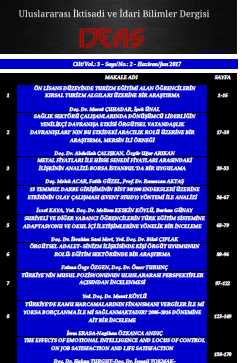ŞİRKETLERİN TEDARİK SÜREÇLERİ VE TALEP YÖNETİMİNDE WEB ENTEGRASYONU SEVİYELERİ VE PERFORMANSA ETKİLERİ: MERSİN SERBEST BÖLGE ÖRNEĞİ
Talep Zinciri Yönetimi, Talep Entegrasyonu, Tedarik Entegrasyonu, Web Entegrasyonu
COMPANIES' SUPPLY PROCESSES AND WEB INTEGRATION LEVELS OF DEMAND MANAGEMENT AND THEIR EFFECTS ON PERFORMANCE: A CASE STUDY IN MERSÄ°N FREE ZONE
___
- Akkoç, İ., Çalışkan, A., Turunç, Ö. (2012). Gelişim ve Rasyonel Alt Kültürlerinin Girişimci Davranışa Etkisi: Algılanan Çevresel Belirsizliğin Aracılık Rolü, Anadolu Üniversitesi Sosyal Bilimler Dergisi, 12, 65-83.
- Armistead, C , Mapes, J. (1993) "The impact of supply chain integration on operating performance", Logistics information management, Vol. 6 Issue: 4, pp.9-14.
- Bhaskaran, S., (1998). Simulation analysis of a manufacturing supply chain. Decision Science 29 (3), 633–657.
- Cambra-Fierro, J. J., ve Polo-Redondo, Y. (2008). Creating satisfaction in the demand-supply chain: the buyers' perspective. Supply chain management: An international journal, 13(3), 211-224.
- Chong, A. Y. L., ve Zhou, L. (2014). Demand chain management: Relationships between external antecedents, web-based integration and service innovation performance. International journal of production economics, 154, 48-58.
- Çalışkan,A., Akkoç, İ., ve Turunç,Ö., (2011), Örgütsel Performansın Artırılmasında Motivasyonel Davranışların Rolü: Yenilikçilik Ve Girişimciliğin Aracılık Rolü. Süleyman Demirel Üniversitesi İktisadi ve İdari Bilimler Fakültesi Dergisi, 16(3):.363-401.
- Çalışkan, A. (2013). İç Odaklı Örgüt Kültürünün Yenilikçi Davranışa Etkisinde Personel Güçlendirmenin Aracılık Rolü, "İş, Güç" Endüstri İlişkileri ve İnsan Kaynakları Dergisi, Cilt: 15, Sayı: 1, 88-112. Devaraj, S., Krajewski, L., ve Wei, J. C. (2007). Impact of eBusiness technologies on operational performance: the role of production information integration in the supply chain. Journal of Operations Management, 25(6), 1199-1216.
- Esper, T. L., Ellinger, A. E., Stank, T. P., Flint, D. J., ve Moon, M. (2010). Demand and supply integration: a conceptual framework of value creation through knowledge management. Journal of the academy of marketing science, 38(1), 5-18.
- Frohlich, M. T., ve Westbrook, R. (2002). Demand chain management in manufacturing and services: web- based integration, drivers and performance. Journal of operations management, 20(6), 729-745.
- Heikkilä, J. (2002). From supply to demand chain management: efficiency and customer satisfaction. Journal of operations management, 20(6), 747-767.
- Hilletofth, P. and Ericsson, D. (2007), “Demand chain management: next generation of logistics management”, Conradi research review, Vol. 4 No. 2, pp. 1-18.
- Hilletofth, P., Ericsson, D. and Christopher, M. (2009), “Demand chain management: a Swedish industrial case study”, Industrial Management ve Data Systems, Vol. 109 No. 9, pp. 1179-96.
- Hilletofth, P. (2011). Demand-supply chain management: industrial survival recipe for new decade. Industrial management ve data systems, 111(2),184-211. Juttner, U., Christopher, M. and Baker, S. (2007), “Demand chain management: integrating marketing and supply chain management”, Industrial marketing management, Vol. 36 No. 3, pp. 377-392.
- Lee, H.L, Billington,C, (1992). Managing supply chain inventory: Pitfalls and opportunities, management review, 65-73.
- Lee, H. L., Padmanabhan, V., ve Whang, S. (1997). Information distortion in a supply chain: the bullwhip effect. Management science, 43(4), 546-558.
- Mabert, V.A., Venkataramanan, M.A.,(1998). Special research focus on supply chainlinkages: challenges for design and management in the 21st century. Decision Science 29 (3), 537–552.
- Metters, R. (1997). Quantifying the bullwhip effect in supply chains. Journal of operations management, 15(2), 89–100.
- Narasimhan, R., ve Jayaram, J. (1998). Causal Linkages in Supply Chain Management:An exploratory study of North American manufacturing Firms. Decision sciences, 29(3), 579–605.
- O’Leary-Kelly, S.W., Vokurka, R.J., (1998) The empirical assessment of construct validity. Journal of Operations Management 16, 387–405.
- Rainbird, M. (2004), “Demand and supply chains: the value catalyst”, International Journal of Physical Distribution ve Logistics Management, Vol. 34 Nos 3/4, pp. 230-51.
- Selen, W., ve Soliman, F. (2002). Operations in today’s demand chain management framework. Journal of Operations Management, 20(6), 667-673.
- Sun, H., ve Ni, W. (2012). The impact of upstream supply and downstream demand integration on quality management and quality performance. International Journal of Quality ve Reliability Management, 29(8), 872-890.
- JĂĽttner, U., Christopher, M., ve Baker, S. (2007). Demand chain management-integrating marketing and supply chain management. Industrial marketing management, 36(3), 377-392.
- Williams, T., Maull, R. and Ellis, B. (2002), “Demand chain management theory: constraints and development from global aerospace supply webs”, Journal of operations management, Vol. 20 No. 6, pp. 691-706.
- ISSN: 2149-5823
- Başlangıç: 2015
- Yayıncı: Ömer TURUNÇ
MESLEK AŞKI (CALLING) ÖLÇEĞİ TÜRKÇE GEÇERLİLİK VE GÜVENİLİRLİK ÇALIŞMASI
Tuğba ERHAN, Tahsin AKÇAKANAT, Hasan Hüseyin UZUNBACAK, Ahmet YILDIRIM
SOSYAL MEDYA KULLANIMININ MARKA ALGISINA ETKİSİ: İLAÇ SEKTÖRÜNDE BİR UYGULAMA
Mustafa KABASAKAL, Ä°lkay Ă–ZTĂśRK
YENİLİKÇİ DAVRANIŞ: BİR ÖLÇEK UYARLAMA ÇALIŞMASI
Abdullah ÇALIŞKAN, İrfan AKKOÇ, Ömer TURUNÇ
BULANIK ÇKKV METODU KULLANARAK DEĞER AKIŞ HARİTALAMA UYGULAMASI
